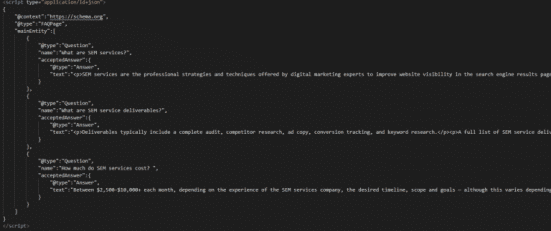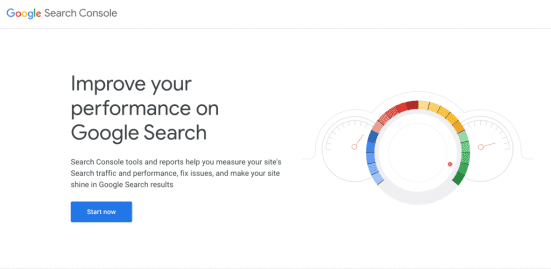Schema markup (aka structured knowledge) is a sort of code that helps web sites talk extra clearly with search engines like google. On this newbie’s information, we’ll go over find out how to implement it appropriately, find out how to audit it, and why it’s essential.
Communication is the important thing to each wholesome relationship; even between a search engine and your web site.
Enter: Schema markup, a particular language that helps crawlers like Google rapidly decide the kind of content material they’re about to learn.
Whereas it’s not necessary, including this code to the backend of your web site can enhance your model authority, consciousness, and place on the search engine outcomes web page (SERP).
In different phrases, it’s a reasonably strong approach to enhance SEO (website positioning).
However understanding what sort of schema markup to make use of (and the place to place it) is vital — and that is the place a schema markup audit comes into play.
What’s schema markup?
Schema markup is a sort of code that helps web sites talk extra clearly with any and all search engines like google (Google, Bing, Yandex, and so on.).
This language, additionally referred to as structured data, permits search engines like google to categorize content material effectively, which frequently means wealthy outcomes:
Wealthy outcomes for native enterprise. (Picture: Screenshot)
Utilizing schema markup (appropriately) in your web site can assist your webpages:
- Talk with search engines like google
- Rank increased within the SERP
- Take up extra actual property on SERPs with wealthy snippets
- Seem on Google’s Knowledge Graph
What’s extra, it may possibly supply extra management over your model look, assist optimize for voice assistants, and enhance your semantic construction and technique.
What schema markup is not
Schema markup is not a requirement. (Nope, you gained’t be penalized by Google when you don’t use it.)
Neither is it an website positioning “hack.” It is, nevertheless, a missed alternative for extra visibility when you don’t implement it.
See, structured knowledge vocabulary helps your website positioning the identical approach high quality content material assists your website positioning. You possibly can’t “work the system,” however you should use it to your benefit.
How schema markup works
Consider schema markup as little labels all through your web site.
These “labels” (i.e. snippets of code) are pasted into the backend of sure webpages and assist search engines like google higher perceive what sort of web page content material they’re about to crawl — assume “recipe web page,” “homepage,” “FAQs,” “weblog or article,” and “native enterprise data.”
That approach, crawlers like Google can extra simply perceive the content material and acknowledge the way it must be displayed on the search engine outcomes web page (SERP).
The excellent news is you don’t must be a grasp coder so as to add schema markup to your web site, due to Schema.org.
This on-line library homes a protracted record of net web page classes, widespread properties that exist on these kinds of pages, and a common code that acts as a “label” for these related web page sorts.
This language (code) may be pasted into your web site for all search engines like google to learn and perceive.
Right here’s the kicker: This on-line useful resource was based and developed by way of the stunning collaboration of Google, Microsoft, Yahoo, and Yandex.
Whereas schema markup is the “widespread language,” there are three schema encoding sorts to select from. Consider this as regional dialects inside america.
Certain, English is the widespread language — however everyone knows issues sound fairly totally different from the Midwest to the South, for instance.
These three encoding sorts embrace:
- Useful resource Descriptive Framework in Attributes (RDFa)
- Microdata
- Javascript Object Notation for Linked Objects (JSON-LD) – which is Google’s beneficial coding sort
What does schema markup appear like?
Whereas an ordinary search end result reveals the title tag, meta description, and URL, schema markup can assist you get wealthy outcomes (or featured snippets), these enticing outcomes with additional visuals, interactive options, and aptitude.
(Picture: Google SERP screenshot)
Keep in mind: Wealthy outcomes are totally different from featured snippets. Whereas wealthy outcomes are the results of directions given to a search engine by your web site.
Featured snippets are extractions from content material that Google deems most related and helpful to the search question, sometimes sitting at place zero.
Consider it as a useful information saying, “Hey, Google, this webpage is a couple of recipe. Right here’s the recipe identify, scores, substances, cooking time, and a photograph to incorporate within the outcomes.”
On the backend facet of issues, schema markup seems to be rather less aesthetically pleasing and somewhat extra like code:

(Picture: Screenshot)
Sorts of schema markup
Very like a library or a report retailer the place a lot of works are organized by style, most webpages may be sorted into widespread classes — i.e. schema sorts.
For instance, a web site like Minimalist Baker would use “recipe” schema markup sorts for nearly all of their webpages. Recipe schemas have sections for substances, cooking directions, prep time, and evaluations or star scores.
When a search engine sees this specific schema sort, it understands the web page is a recipe and would possibly present a preview within the search outcomes.

(Picture: Screenshot)
Whereas there are over 800 kinds of schema markup, Schema.org lists the next as some generally used sorts:
- Artistic works (i.e. guide, film, music recording, recipe, or TV sequence)
- Embedded non-text objects (i.e. audio, picture, or video)
- Breadcrumb schema
- Occasion
- Well being and medical sorts
- Group
- Individual
- Place, native enterprise, restaurant
- Product or supply
- Assessment
- Motion
There’s a full record of structured knowledge sorts you should use for markup (verify ‘em out on schema.org).
Figuring out what kinds of schema markup make sense on your web site is step one of implementing schema markup — and one of many major objectives of a structured knowledge audit.
What’s a schema markup audit?
A schema markup audit is the method of scanning by way of each web page on the backend of your web site to search out:
- What structured knowledge is already on the positioning
- If there are any errors or points that exist with the information discovered
- What alternatives exist (i.e. structured knowledge that is perhaps lacking)
And, after all, no audit is full and not using a plan for implementation. The aim of an audit is to be sure you have the perfect schema sorts obtainable on your web site.
Conducting a schema markup audit helps establish how your web site may talk extra clearly — and maximize all of your SEO (website positioning) efforts to enhance your natural site visitors and, in the end, conversions.

(Picture: Unsplash)
What you’ll want on your schema audit
An audit usually requires two software program functions:
- Google Search Console
- A paid device like SiteBulb, Screaming Frog, or SEMRush
Auditing your schema markup with Google Search Console

(Picture: Google Search Console screenshot)
Google Search Console (GSC) doesn’t report on all schema sorts, however it does present you any errors that may exist.
Right here’s how:
Log in to your Google Search Console and select “Enhancements” from the left sidebar.
You’ll see a listing of errors and warnings. From there, you’ll be pointed to pages which are at the moment affected by the problems. Invalid errors seem in crimson textual content.
For added details about structured knowledge in your pages, you should use Google’s URL Inspection Tool and Structured Data Testing Tool. This a part of the audit course of is free.
Auditing your schema markup with a paid device

Whereas Screaming Frog isn’t free, this crawling device has plenty of advantages — together with a complete schema markup audit.
This device will present all the information you want for schema markup evaluation, together with lacking structured knowledge, validation errors, validation warnings, and parse errors in addition to Microdata, JSON-LD, and RDFa URLs.
Whew.
If you happen to resolve to put money into Screaming Frog, you’ll be able to audit your schema markup by taking these straightforward steps:
- Click on Configuration > Spider
- Select the “extraction” tab
- Scroll right down to “structured knowledge”
- Examine all of the packing containers
Then, run the crawling characteristic.
Semrush is one other device we suggest that has a web site audit device that can assist you to uncover errors inside your web site.
Auditing your schema markup with SiteBulb

One other paid device (with a free trial) that may assist with a schema markup audit is SiteBulb. It might probably present precious details about your structured knowledge and supply insights into coping with present issues.
Within the “Audit Knowledge” part, choose the “structured knowledge” slider. When the device finishes crawling your web site, select “structured knowledge” underneath “all hints.”
If the device finds structured knowledge that doesn’t adjust to Schema.org, it can return validation errors. Together with the error message, you’ll get error particulars, hyperlinks to related assets, and recommendation that can assist you cope with the issue.
Lastly, use testing tools on a per-page foundation. The Rich Results Test tool helps decide what wealthy outcomes may be generated on your web page.
And you should use the Schema Markup Validator to check kinds of https://schema.org markup — with out Google-specific validation.
Hole evaluation and competitor evaluation
Utilizing these auditing instruments, you’ll get a good suggestion of any errors that exist in your web site. However there are some guide steps it is best to take as properly.
Take a look at schema.org’s list of available schema types. When you learn by way of the record, assume again to your personal web site. Do any of the schema sorts listed resonate together with your content material? Are you lacking alternatives so as to add schema markup?
Or perhaps you’re lacking content material altogether that must be added to your web site (with somewhat schema markup love added as soon as it’s dwell).
Consider this a part of your schema audit as a content material creation alternative.
When you’re at it, check out what your competitors rank for in snippets and make it a precedence to beat ‘em.
Right here’s a simple place to begin:
- Ecommerce can usually implement product and evaluation schema
- Lead technology can usually implement evaluation schema
- Each ought to implement a business-type schema
- If FAQs or how-tos exist, mark these up as properly
After you employ your auditing device to evaluate your present structured knowledge markup, you will get to the implementation course of.
How one can implement schema onto your web site
Relying in your content material administration system (CMS), corresponding to WordPress and Joomla, there are plugins you should use to implement your schema markup simply and rapidly, even when you don’t have site owners that can assist you.
You too can write scripts manually and implement through HTML tags.
Want somewhat assist? You should use a schema markup generator! For instance, Google’s structured data markup helper offers you a hand in including structured knowledge markup to a pattern webpage.
Irrespective of the way you implement the code, make sure to verify them together with your testing instruments.
Relying on the kinds of schema you implement, it ought to pop up inside GSC as soon as crawled by Google.
Keep in mind, GSC doesn’t inform you if you’re rating for a snippet — simply that the markup was discovered and processed. You’ll want to watch with instruments like Semrush for precise outcomes.
How typically to conduct a schema markup audit
A schema markup audit must be a part of your common SEO audit and carried out early on to find out what sort of schema must be included in your web site.
Relying on the kind of web site you’ve gotten, you could think about operating these audits at the very least twice a yr. That mentioned, ecommerce web sites might have to do it extra typically (about each three months).
Listed here are just a few causes to rearrange an audit forward of schedule:
- Poor website positioning outcomes
In case your website positioning efforts aren’t yielding the specified outcomes, you could wish to run a schema markup earlier than it’s scheduled.
- Google algorithm replace
It’s additionally a good suggestion to run an audit after a core Google algorithm update. Whereas Google doesn’t verify that schema markup is a direct rating issue, it may change its thoughts at any time.
- Wealthy snippets
Take into account that schema markup improves the looks of wealthy snippets. If you happen to aren’t proud of what they appear like on the SERPs, you could have to evaluation the structured knowledge.
Can schema markup really harm website positioning?
Whereas the advantages of schema markup for SEO is hardly a secret (as mentioned above), it’s solely truthful to provide the total image right here:
There may (perhaps?) be some potential drawbacks to utilizing schema markup on the subject of technical website positioning. There’s a slight probability that the more snippets you have, the lower your click-through rate (CTR).
Why? As a result of, in concept, all the data a searcher wants is (typically) featured in that single snippet on the SERP.
However that additionally means enhanced snippets usually tend to improve your model consciousness. And whereas Google refuses to name it a rating issue, digital entrepreneurs agree it’s integral to optimizing your website positioning efforts.
For this reason conducting common markup audits ensures the integrity and effectiveness of structured knowledge by validating the standard of your code and ensuring it’s dwell on all related pages.
The takeaway
Schema markup audits are needed to make sure the success of your website positioning efforts and push them to the restrict. They can assist you establish errors that stop main search engines like google from indexing your web site appropriately.
Even when you’re glad together with your advertising outcomes, you continue to have to audit structured knowledge at the very least annually.
Each free and paid instruments exist to assist simplify schema markup audits. But when conducting your personal audit feels daunting, we can assist — simply reach out.
This text has been up to date and was initially revealed in October 2022.
FAQs
Why is schema markup essential?
Schema markup and website positioning go hand-in-hand. By bettering how search engines like google interpret your content material, schema markup can result in enhanced search outcomes corresponding to:
- Wealthy snippets
- Data panels
- Improved click-through charges
Whereas it doesn’t instantly have an effect on the rankings themselves, it may possibly enhance person expertise and visibility.
Can I check to ensure my schema markup is carried out appropriately?
Sure! For instance, Google’s Wealthy Outcomes Check and Google’s Structured Knowledge Testing Device can validate your schema markup.
These instruments present how your schema will seem in search outcomes, and notifies you of any errors.
What are some widespread errors when implementing schema markup?
Widespread errors embrace:
- Utilizing schema sorts that don’t match the content material
- Not updating the markup with content material modifications
- Incorrect or incomplete markup
- Failing to check the markup for errors
Can I exploit schema markup for native website positioning?
Sure, it may be very useful for native website positioning! For example, utilizing Native Enterprise schema can assist search engines like google show enterprise particulars like tackle, cellphone quantity, hours, and even social media in native search outcomes.
Is there a restrict to how a lot schema markup I can use on one web page?
No, there’s not a restrict. Nonetheless, it’s essential so as to add solely related and correct schema markup to your pages.
Overdoing it with plenty of pointless or incorrect knowledge can result in errors (and doubtlessly confuse search engine crawlers).

